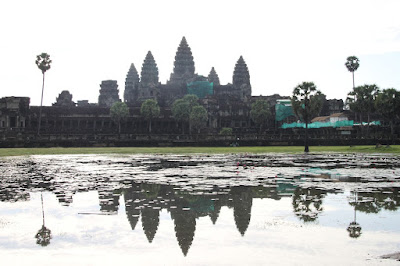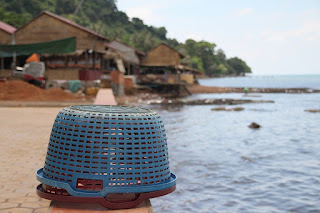After our great time in Laos, Judith & I knew that Cambodia would have a tough time to convince us of its beauty. Nevertheless, despite its cruel history and poverty-stricken present, we managed to leave Cambodia with some positive impressions in the end.
We had booked a bus from Laos to Siem Reap, the hub for tourist-paradise Angkor. However, the bus which was supposed to pick us up in a town after the border allegedly had broken down – yeah, right. The mini-van substitute sped like crazy, and we were kind of relieved to change yet again into what turned out to be a complete disaster of a bus with broken windows, holes in the floor, and trash and spare parts flying around. The landscapes we passed were either flooded (that's what you get for being a flat country in rainy season) or full of signs warning of land mines. Anyway, we were astonished to see that the bus did make it to Siem Reap eventually. After having successfully avoided a couple of tourist scams, we finally managed to check into our guest house. Actually, the guys trying to pull the scams did it in such an obvious way (the hostel you have booked 1. “is full”, 2. “is closed”, 3. “burnt down yesterday”) that it was almost cute.
 Siem Reap, aka Siem Reap Off, is a fairly big city which exists for one reason and one reason only: extracting money from the more than 1 million tourists who visit the world famous temple of Angkor Wat every year. As a result, the city only consists of hotels, restaurants, dirt cheap bars (24 hour happy hour featuring beer for US$ 0.5, wohoooo!), and massage parlours, some of which offer “happy endings” for their clients. This might sound horrible, but Judith & I very much enjoyed being in a place providing everything a tourist could wish for (excluding the happy endings, of course). For our six-month travel anniversary, we even managed to find a German restaurant featuring sausages, sauerkraut, and most importantly, nice beer. Hmm, Erdinger.
Siem Reap, aka Siem Reap Off, is a fairly big city which exists for one reason and one reason only: extracting money from the more than 1 million tourists who visit the world famous temple of Angkor Wat every year. As a result, the city only consists of hotels, restaurants, dirt cheap bars (24 hour happy hour featuring beer for US$ 0.5, wohoooo!), and massage parlours, some of which offer “happy endings” for their clients. This might sound horrible, but Judith & I very much enjoyed being in a place providing everything a tourist could wish for (excluding the happy endings, of course). For our six-month travel anniversary, we even managed to find a German restaurant featuring sausages, sauerkraut, and most importantly, nice beer. Hmm, Erdinger. On day two, we headed to the ancient city of Angkor. Angkor comprises a lot more than Angkor Wat itself. There are dozens of huge temples, palaces, and urban structures, which were built at the peak of the Khmer empire in the 9th to the 13th century. In fact, many historians think that the construction of Angkor itself eventually was responsible for the downfall of the mighty Khmer rulers, since it overstretched the available resources. Kind of like Western welfare states today, just with more temples. Anyway, Angkor is really, really impressive: it is to man-made ancient structures what Alberto Contador is to the Tour de France, just without the doping. In the evening, Judith & I headed up a little hill to see the sunset over the many temples, alongside 1000 friendly Japanese travelling in tourist groups. We felt like being back at Shinjuku Station in Tokyo.
 The next morning, we got up early to watch the sunrise at Angkor Wat itself. At 5 am. Usually, I only get up that early when somebody pays me to do so. Sunrise at Angkor Wat is a tourist mass event, but after our Japanese tour group friends had left, Judith & I had large parts of the massive compounds to ourselves. Beautiful. Actually, Angkor Wat had first been built as a Hindu temple, but after Buddhism gained the upper hand in the Khmer empire, they simply blocked the entrance to the inside of the temple, where the massive Shiva statues used to be located. That's Khmer pragmatism for you. After Angkor Wat, we headed on to many of the other temples & palaces, accompanied by our funny Tuk-Tuk driver. The most memorable things we saw were the “tree temple” (an Indiana Jones-esque structure with trees & tropical vegetation rising from its massive walls) and the “face temple” (featuring, you wouldn't have guessed, dozens of Buddha busts carved into massive bricks). Rather than boring you to death with endless descriptions of what we saw, we will let the pictures below speak for themselves... Attentive observers might also notice that we have discovered the monochrome-function of our camera – simple, but nice.
The next morning, we got up early to watch the sunrise at Angkor Wat itself. At 5 am. Usually, I only get up that early when somebody pays me to do so. Sunrise at Angkor Wat is a tourist mass event, but after our Japanese tour group friends had left, Judith & I had large parts of the massive compounds to ourselves. Beautiful. Actually, Angkor Wat had first been built as a Hindu temple, but after Buddhism gained the upper hand in the Khmer empire, they simply blocked the entrance to the inside of the temple, where the massive Shiva statues used to be located. That's Khmer pragmatism for you. After Angkor Wat, we headed on to many of the other temples & palaces, accompanied by our funny Tuk-Tuk driver. The most memorable things we saw were the “tree temple” (an Indiana Jones-esque structure with trees & tropical vegetation rising from its massive walls) and the “face temple” (featuring, you wouldn't have guessed, dozens of Buddha busts carved into massive bricks). Rather than boring you to death with endless descriptions of what we saw, we will let the pictures below speak for themselves... Attentive observers might also notice that we have discovered the monochrome-function of our camera – simple, but nice. Soon, it was time to move on to Cambodia's capital, Phnom Penh. Again, we felt relieved to have survived the bus ride. Judith in particular grew so frustrated at the concept of riding on a bus that we decided to skip one or two other stops we had initially planned. Pmonh Phen is a strange place: besides being shockingly dirty & poor, the city has a strange atmosphere to it. Somehow, despite some 1-2 million inhabitants, Pehn Pmhno doesn't feel urban at all. This is where the Angkar comes in. “Angkar” in Khmer means “organisation” and it's the term used for the Khmer Rouge, the world's most brutal regime in recent decades. Under the leadership of Pol Pot, the Angkar tried to establish a form of communism using extremely cruel social engineering measures. Their aim was to build a completely uniform, rural, agrarian society, renouncing all scientific and mechanical progress. To achieve this, they killed everybody who didn't fit into that picture. People with a secondary or tertiary education, monks, non-Khmer Cambodians, people living in cities, people wearing glasses (suspiciously intellectual) – they all got killed. I presume that everybody reading this blog would have been killed, too. Only 4 years of terror (1975 – 1979) were sufficient for the Khmer Rouge to kill roughly 25% of the total population – either by beheading their “enemies” (to save precious bullets) or by starving to death the rural population to buy weapons from China in exchange for rice. Allegedly, by 1979, there was not a single architect left in the country.
Judith & I went to visit the Toul Sleng Museum of Genocide, a former school-turned-torture-prison. The place definitely is a shocker, particularly considering how recent those events were. Coming back to my point on Pnem Ponh: basically, it's a large city, but its inhabitants really are rice farmers from the countryside, since the original population has been exterminated. No wonder it doesn't feel urban.
Since the fall of the Khmer Rouge (its commie neighbours from 'Nam eventually invaded the country and ousted the regime), Cambodia has improved, but is still quite unstable. The opposition leader has just been sentenced to ten years in prison in absentia, and corruption is rampant. The huge number of armoured luxury SUVs speeding through the country next to people not being able to earn a decent living is shocking. Since there is no proper industry or service sector in Cambodia, I wonder how those rich people got rich in the first place. On a totally unrelated matter, Transparency International's Corruption Perception Index (2009) ranks Cambodia at an impressive 158 out of 180 countries. That's worse than Mugabe's Zimbabwe (rank 146), and just a wee bit better than the Central African Republic (rank 159), which I didn't even know existed. Compared to most of its South East Asian peers, that's just appalling.
Ooops, I got carried away. Apologies. Anyway, we ended up making one more stop after Pnem Pohnh after all. We took a bus (sorry, Judith) to the coastal town of Kep, a former beach resort built for the French colonial elite. In Kep, we enjoyed the very friendly people, the good seafood, fresh pepper, and a day of driving irresponsibly fast with a little scooter we had rented.
Soon, though, it was time to say goodbye to the thirteenth country on our trip. To summarise: Cambodia definitely left a strong impression on us: both in good ways (e.g. fabulous Angkor) and in bad (e.g. horrific Angkar, corruption). From Phnom Penh, we took a pleasantly cheap Air Asia flight to Kuala Lumpur. Flying felt great again after weeks on break-neck bus rides. I'm not sure if the guy next to us (who obviously was on the first flight of his life) thought so, too. Our next two stops, Malaysia and Singapore, were very different to Cambodia and featured some big surprises. I'll try to post again over the next two days (!!!), this time for reals. Muchas gracias, senoritas.


















WOW, 6 Monate! Und 6 cm längere Haare! Und 6 Nuancen bräuner! Und 6 weitere Länder nach Panama (so ungefähr, oder?)! Und in 6:2 Tagen hat die Juju Geburtstag! Und am 6. Dezember kommt ihr wieder. Und dann mach ich 6 Freudensprünge! Mindenstens! Soviel zu meinen 6 Statisktik-Kenntnissen.
ReplyDelete6 Küsse an euch beide und viiiiel Spaß!
Lene